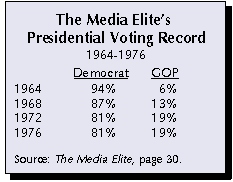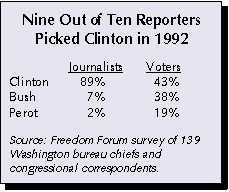 |
||||||||||||
|
||||||||||||
 |
||
|
 |
||||||||||||
|
||||||||||||
 |
||||||||||||||||||||||||||||||||||||
|
||||||||||||||||||||||||||||||||||||
|
The Liberal Media
Every Poll Shows Journalists Are More Liberal than
the American Public — And the Public Knows It
By Rich Noyes
Director of Research
June 30, 2004
Section 1 of 4
|
Over the next four months, the media establishment will play a central role in informing the public about the candidates and the issues. As the countdown to Election Day begins, it is important to remember the journalists who will help establish the campaign agenda are not an all-American mix of Democrats, Republicans and independents, but an elite group whose views veer sharply to the left. Most journalists deny that their profession is stacked with liberals. “I’ve worked around reporters all my life,” CBS anchor Dan Rather declared in an appearance on The Late Late Show with Tom Snyder back on February 8, 1995. “Most reporters, when you get to know them, would fall in the general category of kind of common sense moderates.” ABC’s Peter Jennings echoed Rather. “We are largely in the center without particular axes to grind, without ideologies which are represented in our daily coverage — at least certainly not on purpose,” Jennings told CNN’s Larry King on May 15, 2001. “The idea that we would set out, consciously or unconsciously, to put some kind of ideological framework over what we’re doing is nonsense,” NBC’s Tom Brokaw similarly declared on C-SPAN just a few days later, on May 24, 2001. But study after study shows that Rather, Jennings and Brokaw are wrong: the newsrooms of major media outlets are not filled with non-ideological “common sense moderates,” nor do they reflect a diverse range of ideological viewpoints. Surveys over the past 25 years have consistently found journalists are much more liberal than rest of America. Their voting habits are disproportionately Democratic, their views on issues such as abortion and gay rights are well to the left of most Americans and they are less likely to attend church or synagogue. When it comes to the free market, journalists have become increasingly pro-regulation over the past 20 years, with majorities endorsing activist government efforts to guarantee everyone a job and to reduce the income gap between rich and poor Americans. This MRC Special Report summarizes the relevant data on journalists’ attitudes, as well as polling showing how the American public’s recognition of the media’s liberal bias has grown over the years.
Journalists on Election Day: Pulling the Democratic Lever Between 1964 and 1992, Republicans won the White House five times compared with three Democratic victories. But if only journalists’ ballots were counted, the Democrats would have won every single election. In their 1986 book, The Media Elite, political scientists S. Robert Lichter, Stanley Rothman and Linda S. Lichter reported the results of their survey of 240 journalists at the nation’s top media outlets: ABC, CBS, NBC, PBS, the New York Times, Washington Post, Wall Street Journal, Time, Newsweek and U.S. News & World Report. When asked about their voting patterns, journalists admitted their preference for Democrats:
Lichter’s team focused on journalists at the very top national news organizations. Other surveys of journalists have discovered that the whole profession shares the same liberal bent, although the media elite’s liberalism is the most extreme: • Journalists Picked Carter over Reagan: In 1982, scholars at California State University at Los Angeles asked reporters from the fifty largest newspapers for whom they voted in 1980. The breakdown: 51 percent cast a ballot for President Jimmy Carter and another 24 percent chose independent candidate (and liberal Republican Congressman) John Anderson. Only 25 percent picked conservative Ronald Reagan, who won 51 percent of the public’s vote that year.
• The White House Press Corps Voted for Democrats: In early 1995, Ken Walsh of U.S. News & World Report asked his fellow White House reporters to fill out a survey for a book he was writing; 28 returned his questionnaire. He concluded that “the White House press corps is overwhelmingly Democratic, confirming a stereotype often promoted by Republicans.” Interestingly, he also learned how much reporters dislike being on the receiving end of personal inquiries: “Even though the survey was anonymous, many journalists declined to reveal their party affiliations, whom they voted for in recent presidential elections, and other data they regarded as too personal — even though they regularly pressure Presidents and other officials to make such disclosures,” Walsh related in his 1996 book, Feeding the Beast: The White House Versus the Press. So what did the few forthright scribes reveal? As with larger, more scientific surveys, Walsh discovered “evidence of an overwhelming preference for Democrats in presidential elections. In 1992, nine respondents voted for Clinton, two for George Bush, and one for independent Ross Perot....In 1988, twelve voted for Democrat Michael Dukakis, only one for Bush....In 1984, ten voted for Democrat Walter Mondale, [and] no one admitted voting for Ronald Reagan....In 1980, eight voted for Democratic incumbent Jimmy Carter, two voted for Ronald Reagan, four voted for independent candidate John Anderson....In 1976, eleven voted for Carter and two for Republican incumbent Gerald Ford.” That adds up to 50 votes for Democrats and just seven for Republicans, a seven-to-one ratio in favor of the Democrats. • Huge Majorities for Dukakis and Clinton: In 2001, Stanley Rothman and Amy E. Black updated the Media Elite’s survey of journalists, and learned that reporters continued to select Democrats. “Three-quarters of elite journalists (76.1 percent)...voted for Michael Dukakis in 1988, and even larger percentages (91.3 percent)...cast ballots for Bill Clinton in 1992,” they reported in the Spring 2001 edition of The Public Interest. Voters were far less exuberant about those liberal candidates, as just 46 percent chose Dukakis and only 43 percent picked Clinton, who nevertheless won a three-way race. • Nine Out of Ten Reporters Voted for Clinton: Rothman and Black’s survey closely matched a Freedom Forum poll of Washington bureau chiefs and congressional correspondents, which found 89 percent had voted for Clinton in the 1992 election, compared with seven percent for President Bush and two percent for Ross Perot. “In no state or region, among no race or class, did support for Clinton predominate more lopsidedly than among this sample of 139 journalists who either cover Congress or head a Washington bureau,” summarized Minneapolis Star-Tribune media writer Eric Black in an August 18, 1996 article. The Freedom Forum was not aiming to embarrass journalists by quantifying their liberalism. The report, on relations between Capitol Hill staffers and Washington, D.C. reporters, was released in April 1996, and the data on journalists’ voting pattern was buried in an appendix. The study’s director, former Chicago Tribune reporter Elaine Povich, gamely asserted that reporters’ heavy preference for Bill Clinton did not mean that journalists’ were incapable of being objective. “One of the things about being a professional is that you attempt to leave your personal feelings aside as you do your work,” Povich told the Washington Times on April 18, 1996.
At a minimum, these statistics portray a media elite whose political thinking is to the left of most Americans. Hosting CNN’s Reliable Sources on April 21, 1996, Washington Post media writer Howard Kurtz reacted to the Freedom Forum’s poll: “Clearly anybody looking at those numbers, if they’re even close to accurate, would conclude that there is a diversity problem in the news business, and it’s not just the kind of diversity we usually talk about, which is not getting enough minorities in the news business, but political diversity, as well. Anybody who doesn’t see that is just in denial.”
The Media Research Center For an interview with an MRC Spokesman, please contact Katie Wright at (703) 683-5004
Home | News Division
| Bozell Columns | CyberAlerts |
||||||||





 •
Journalists Picked Mondale over Reagan: In 1985, the Los Angeles Times polled news and editorial staffers at newspapers around the country, weighting the sample so that newspapers with large circulations were more heavily represented. Once again, pollsters discovered a heavy Democratic skew. When asked how they voted in the 1984 election, more than twice as many chose liberal Walter Mondale (58 percent) over the conservative incumbent Ronald Reagan (26 percent), even as the country picked Reagan in a 59 to 41 percent landslide.
•
Journalists Picked Mondale over Reagan: In 1985, the Los Angeles Times polled news and editorial staffers at newspapers around the country, weighting the sample so that newspapers with large circulations were more heavily represented. Once again, pollsters discovered a heavy Democratic skew. When asked how they voted in the 1984 election, more than twice as many chose liberal Walter Mondale (58 percent) over the conservative incumbent Ronald Reagan (26 percent), even as the country picked Reagan in a 59 to 41 percent landslide.
 Taken as a whole, these polls firmly establish the press’s pattern of preferring Democrats at the voting booth. During the eight presidential elections for which data on the media’s preferences are available, each Democrat won landslide support from journalists, sometimes by four-to-one or five-to-one margins. The percentage of reporters selecting the GOP candidate never exceeded 26 percent, even as the public chose Republicans in five of the eight elections, with margins of support ranging from a low of 38 percent (Bush in 1992) to a high of 61 percent (Nixon in 1972).
Taken as a whole, these polls firmly establish the press’s pattern of preferring Democrats at the voting booth. During the eight presidential elections for which data on the media’s preferences are available, each Democrat won landslide support from journalists, sometimes by four-to-one or five-to-one margins. The percentage of reporters selecting the GOP candidate never exceeded 26 percent, even as the public chose Republicans in five of the eight elections, with margins of support ranging from a low of 38 percent (Bush in 1992) to a high of 61 percent (Nixon in 1972).
